Applied Corporate Strategy of Sainsbury: Strategic Analysis Report
VerifiedAdded on 2022/08/15
|18
|4605
|18
Report
AI Summary
This report provides a comprehensive strategic analysis of Sainsbury's, a major UK supermarket chain. It begins with an introduction to the company and its market position, followed by an examination of its opportunities, such as social media, technological developments, and population growth, as well as the threats it faces, including technological advancements by competitors and supplier power. The analysis employs Porter's Five Forces framework to assess the competitive rivalry, barriers to entry, threats of substitutes, buyer power, and supplier power within the industry. An internal analysis of Sainsbury's identifies its strengths, weaknesses, and core competencies, including its logistics, cost structure, and financial position. The report also utilizes the VRIO framework to evaluate Sainsbury's resources and capabilities, determining which provide a competitive advantage. Finally, the report evaluates a recent strategy implemented by Sainsbury using the SAFe criteria. This detailed analysis offers valuable insights into Sainsbury's strategic positioning and future prospects in the competitive UK supermarket industry.
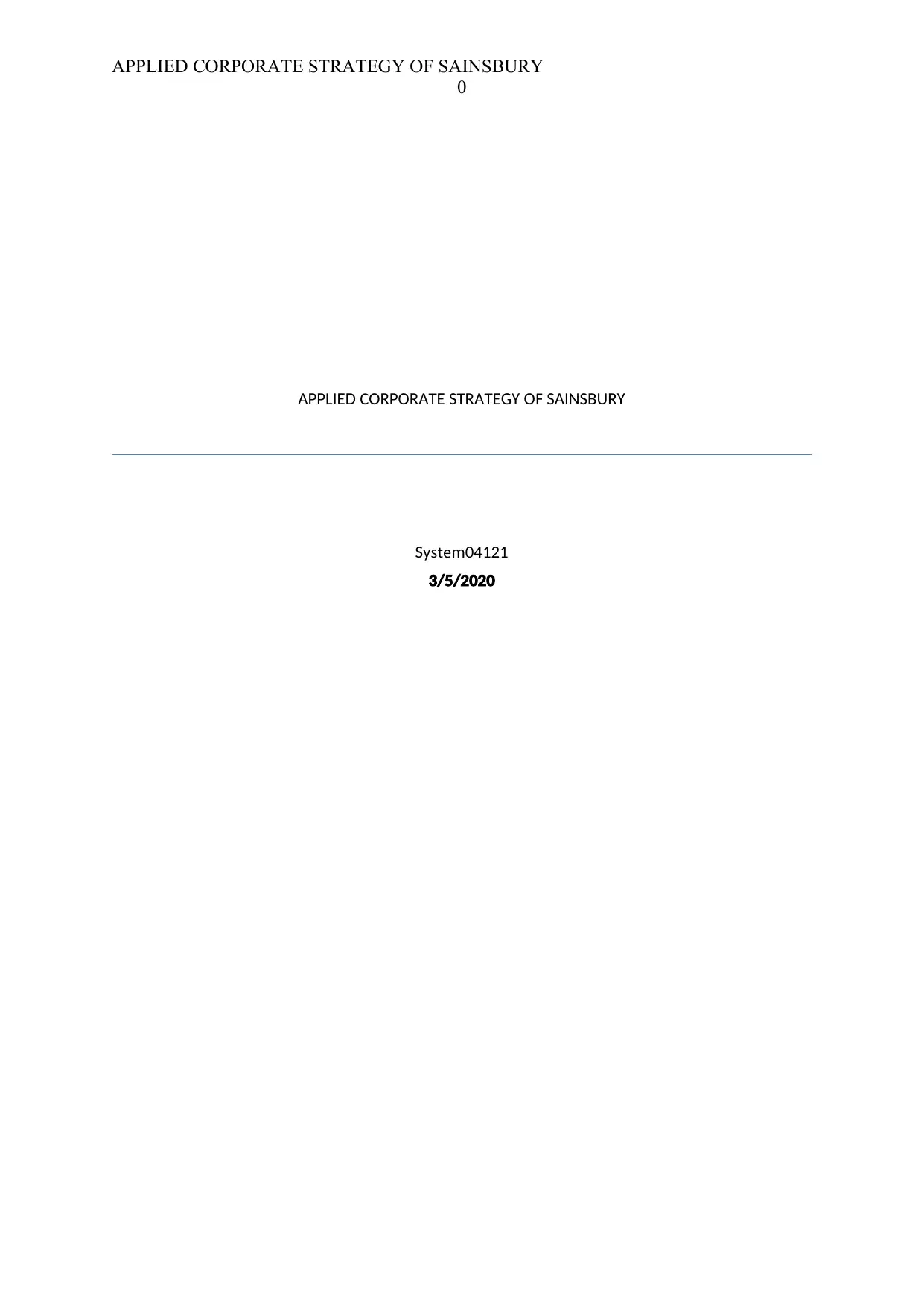
APPLIED CORPORATE STRATEGY OF SAINSBURY
0
C T T T FAPPLIED ORPORA E S RA EGY O SAINSBURY
steSy m04121
3/5/2020
0
C T T T FAPPLIED ORPORA E S RA EGY O SAINSBURY
steSy m04121
3/5/2020
Paraphrase This Document
Need a fresh take? Get an instant paraphrase of this document with our AI Paraphraser
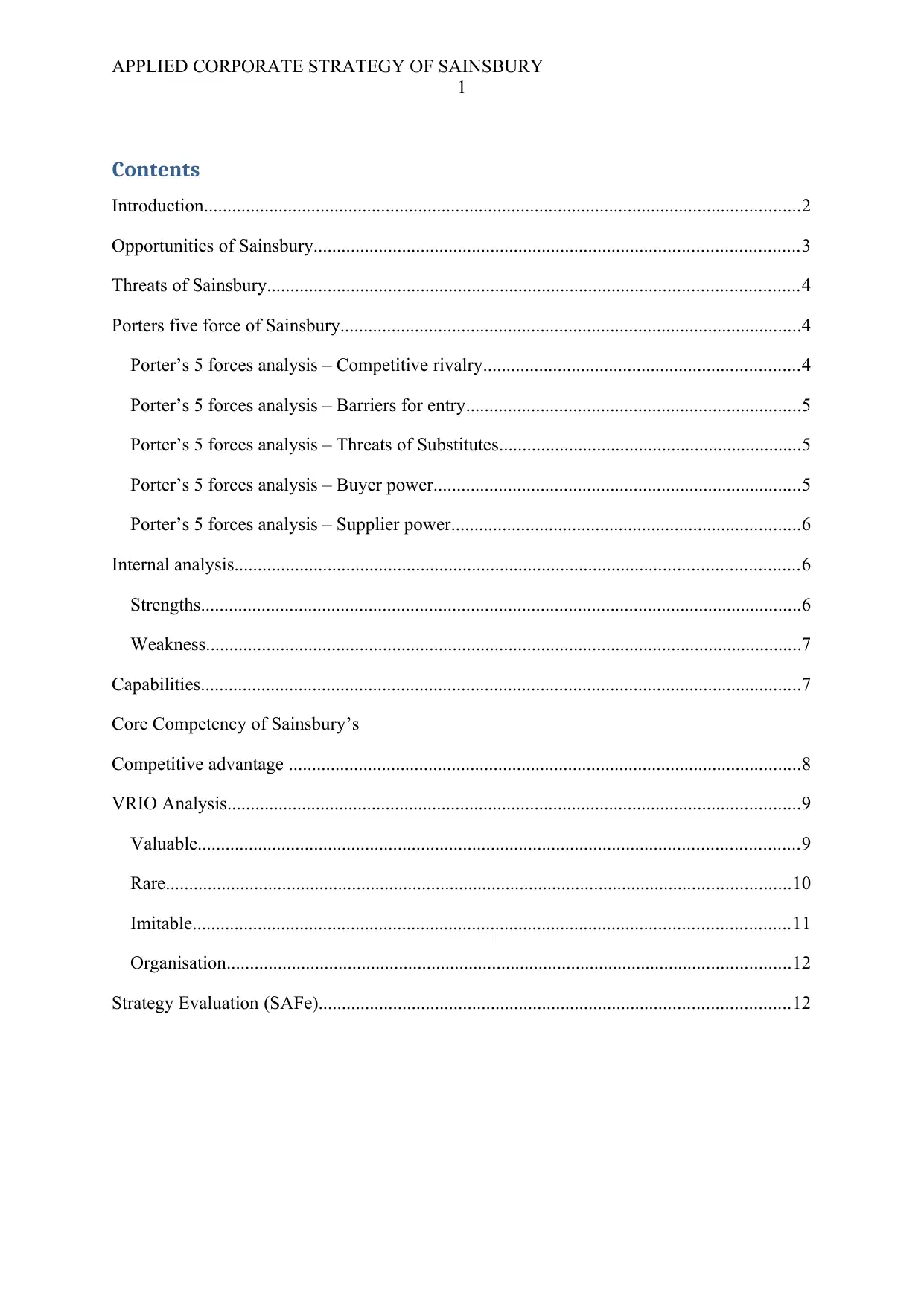
APPLIED CORPORATE STRATEGY OF SAINSBURY
1
Contents
Introduction................................................................................................................................2
Opportunities of Sainsbury........................................................................................................3
Threats of Sainsbury..................................................................................................................4
Porters five force of Sainsbury...................................................................................................4
Porter’s 5 forces analysis – Competitive rivalry....................................................................4
Porter’s 5 forces analysis – Barriers for entry........................................................................5
Porter’s 5 forces analysis – Threats of Substitutes.................................................................5
Porter’s 5 forces analysis – Buyer power...............................................................................5
Porter’s 5 forces analysis – Supplier power...........................................................................6
Internal analysis.........................................................................................................................6
Strengths.................................................................................................................................6
Weakness................................................................................................................................7
Capabilities.................................................................................................................................7
Core Competency of Sainsbury’s
Competitive advantage ..............................................................................................................8
VRIO Analysis...........................................................................................................................9
Valuable.................................................................................................................................9
Rare......................................................................................................................................10
Imitable................................................................................................................................11
Organisation.........................................................................................................................12
Strategy Evaluation (SAFe).....................................................................................................12
1
Contents
Introduction................................................................................................................................2
Opportunities of Sainsbury........................................................................................................3
Threats of Sainsbury..................................................................................................................4
Porters five force of Sainsbury...................................................................................................4
Porter’s 5 forces analysis – Competitive rivalry....................................................................4
Porter’s 5 forces analysis – Barriers for entry........................................................................5
Porter’s 5 forces analysis – Threats of Substitutes.................................................................5
Porter’s 5 forces analysis – Buyer power...............................................................................5
Porter’s 5 forces analysis – Supplier power...........................................................................6
Internal analysis.........................................................................................................................6
Strengths.................................................................................................................................6
Weakness................................................................................................................................7
Capabilities.................................................................................................................................7
Core Competency of Sainsbury’s
Competitive advantage ..............................................................................................................8
VRIO Analysis...........................................................................................................................9
Valuable.................................................................................................................................9
Rare......................................................................................................................................10
Imitable................................................................................................................................11
Organisation.........................................................................................................................12
Strategy Evaluation (SAFe).....................................................................................................12
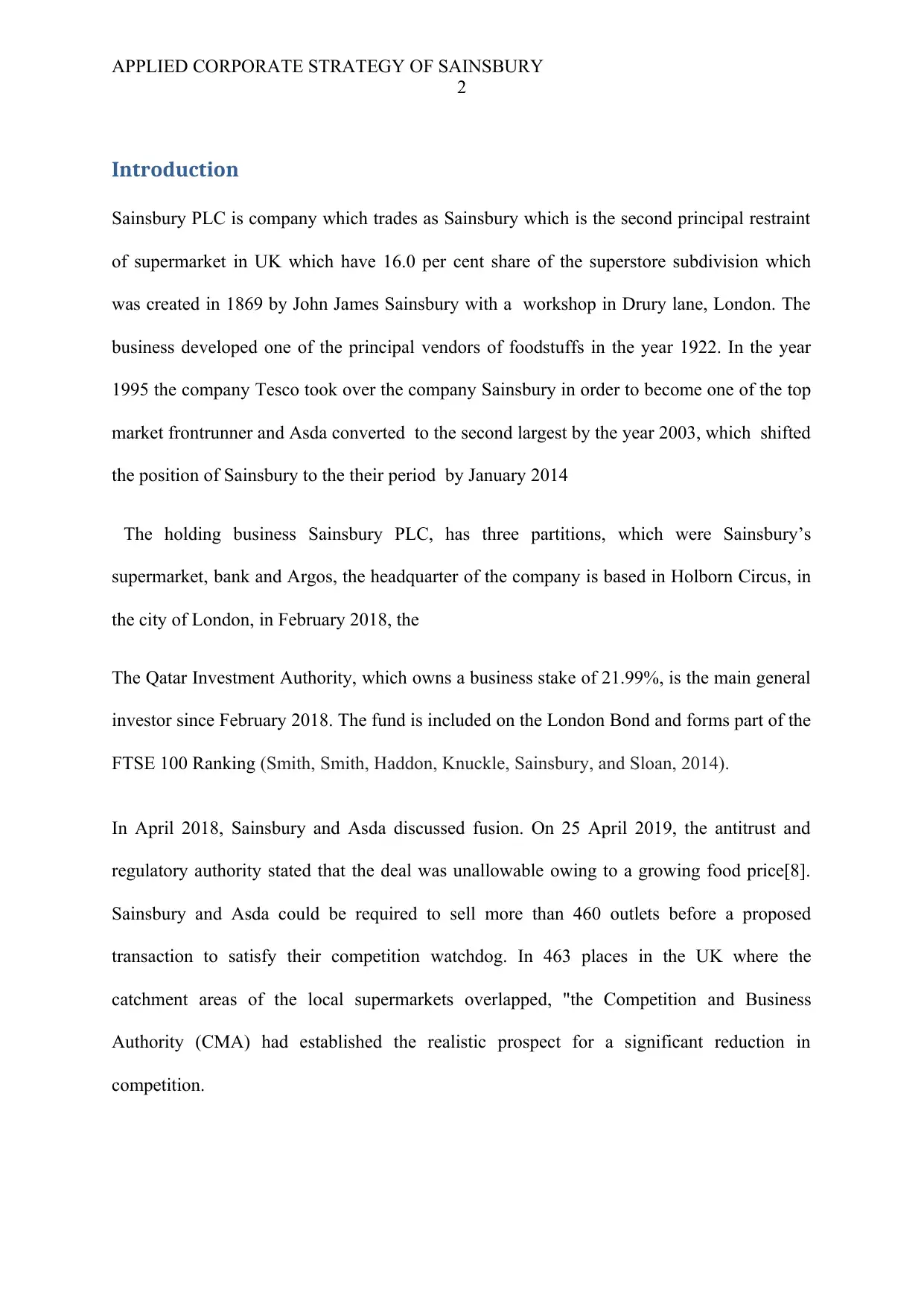
APPLIED CORPORATE STRATEGY OF SAINSBURY
2
Introduction
Sainsbury PLC is company which trades as Sainsbury which is the second principal restraint
of supermarket in UK which have 16.0 per cent share of the superstore subdivision which
was created in 1869 by John James Sainsbury with a workshop in Drury lane, London. The
business developed one of the principal vendors of foodstuffs in the year 1922. In the year
1995 the company Tesco took over the company Sainsbury in order to become one of the top
market frontrunner and Asda converted to the second largest by the year 2003, which shifted
the position of Sainsbury to the their period by January 2014
The holding business Sainsbury PLC, has three partitions, which were Sainsbury’s
supermarket, bank and Argos, the headquarter of the company is based in Holborn Circus, in
the city of London, in February 2018, the
The Qatar Investment Authority, which owns a business stake of 21.99%, is the main general
investor since February 2018. The fund is included on the London Bond and forms part of the
FTSE 100 Ranking (Smith, Smith, Haddon, Knuckle, Sainsbury, and Sloan, 2014).
In April 2018, Sainsbury and Asda discussed fusion. On 25 April 2019, the antitrust and
regulatory authority stated that the deal was unallowable owing to a growing food price[8].
Sainsbury and Asda could be required to sell more than 460 outlets before a proposed
transaction to satisfy their competition watchdog. In 463 places in the UK where the
catchment areas of the local supermarkets overlapped, "the Competition and Business
Authority (CMA) had established the realistic prospect for a significant reduction in
competition.
2
Introduction
Sainsbury PLC is company which trades as Sainsbury which is the second principal restraint
of supermarket in UK which have 16.0 per cent share of the superstore subdivision which
was created in 1869 by John James Sainsbury with a workshop in Drury lane, London. The
business developed one of the principal vendors of foodstuffs in the year 1922. In the year
1995 the company Tesco took over the company Sainsbury in order to become one of the top
market frontrunner and Asda converted to the second largest by the year 2003, which shifted
the position of Sainsbury to the their period by January 2014
The holding business Sainsbury PLC, has three partitions, which were Sainsbury’s
supermarket, bank and Argos, the headquarter of the company is based in Holborn Circus, in
the city of London, in February 2018, the
The Qatar Investment Authority, which owns a business stake of 21.99%, is the main general
investor since February 2018. The fund is included on the London Bond and forms part of the
FTSE 100 Ranking (Smith, Smith, Haddon, Knuckle, Sainsbury, and Sloan, 2014).
In April 2018, Sainsbury and Asda discussed fusion. On 25 April 2019, the antitrust and
regulatory authority stated that the deal was unallowable owing to a growing food price[8].
Sainsbury and Asda could be required to sell more than 460 outlets before a proposed
transaction to satisfy their competition watchdog. In 463 places in the UK where the
catchment areas of the local supermarkets overlapped, "the Competition and Business
Authority (CMA) had established the realistic prospect for a significant reduction in
competition.
⊘ This is a preview!⊘
Do you want full access?
Subscribe today to unlock all pages.

Trusted by 1+ million students worldwide
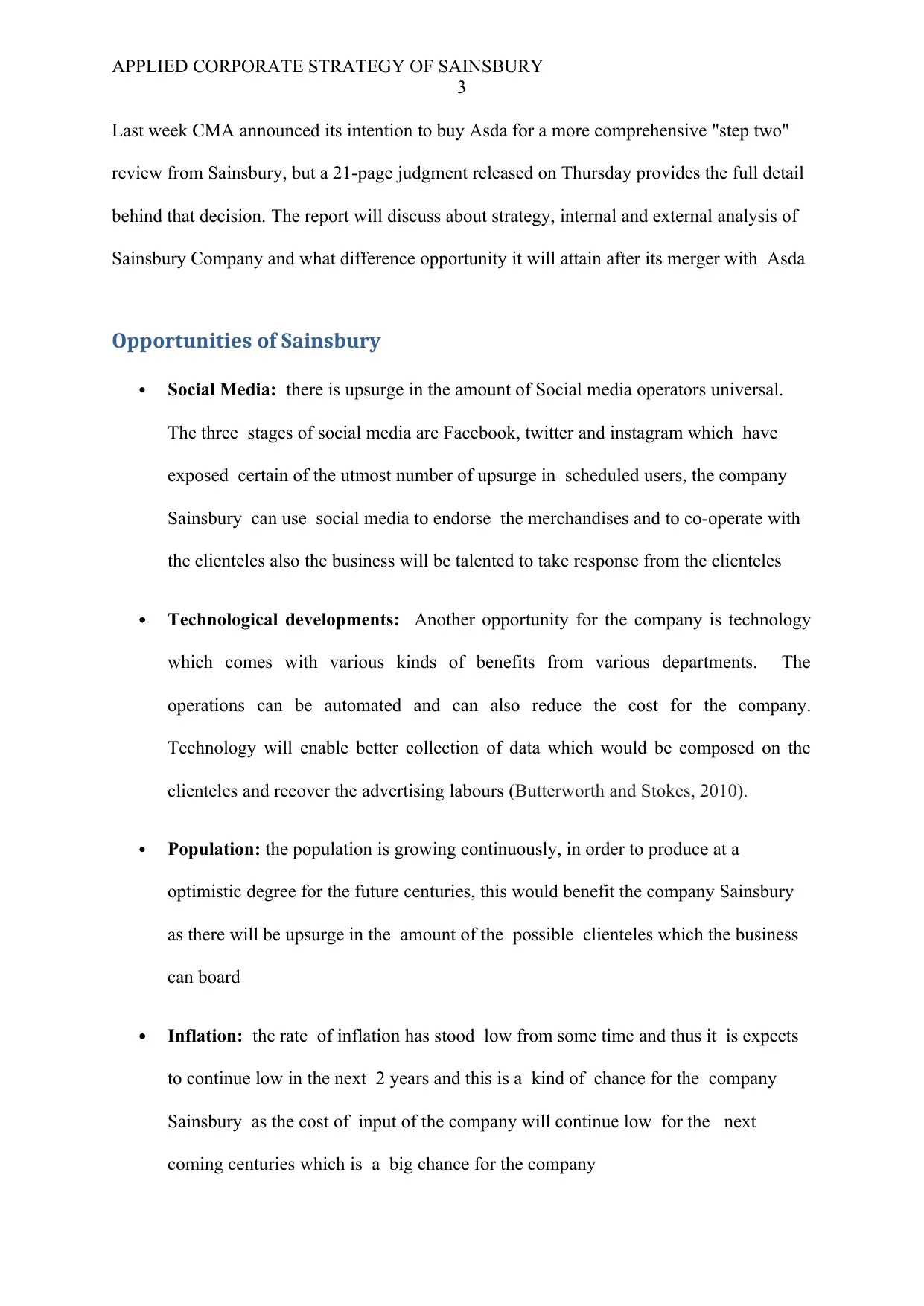
APPLIED CORPORATE STRATEGY OF SAINSBURY
3
Last week CMA announced its intention to buy Asda for a more comprehensive "step two"
review from Sainsbury, but a 21-page judgment released on Thursday provides the full detail
behind that decision. The report will discuss about strategy, internal and external analysis of
Sainsbury Company and what difference opportunity it will attain after its merger with Asda
Opportunities of Sainsbury
Social Media: there is upsurge in the amount of Social media operators universal.
The three stages of social media are Facebook, twitter and instagram which have
exposed certain of the utmost number of upsurge in scheduled users, the company
Sainsbury can use social media to endorse the merchandises and to co-operate with
the clienteles also the business will be talented to take response from the clienteles
Technological developments: Another opportunity for the company is technology
which comes with various kinds of benefits from various departments. The
operations can be automated and can also reduce the cost for the company.
Technology will enable better collection of data which would be composed on the
clienteles and recover the advertising labours (Butterworth and Stokes, 2010).
Population: the population is growing continuously, in order to produce at a
optimistic degree for the future centuries, this would benefit the company Sainsbury
as there will be upsurge in the amount of the possible clienteles which the business
can board
Inflation: the rate of inflation has stood low from some time and thus it is expects
to continue low in the next 2 years and this is a kind of chance for the company
Sainsbury as the cost of input of the company will continue low for the next
coming centuries which is a big chance for the company
3
Last week CMA announced its intention to buy Asda for a more comprehensive "step two"
review from Sainsbury, but a 21-page judgment released on Thursday provides the full detail
behind that decision. The report will discuss about strategy, internal and external analysis of
Sainsbury Company and what difference opportunity it will attain after its merger with Asda
Opportunities of Sainsbury
Social Media: there is upsurge in the amount of Social media operators universal.
The three stages of social media are Facebook, twitter and instagram which have
exposed certain of the utmost number of upsurge in scheduled users, the company
Sainsbury can use social media to endorse the merchandises and to co-operate with
the clienteles also the business will be talented to take response from the clienteles
Technological developments: Another opportunity for the company is technology
which comes with various kinds of benefits from various departments. The
operations can be automated and can also reduce the cost for the company.
Technology will enable better collection of data which would be composed on the
clienteles and recover the advertising labours (Butterworth and Stokes, 2010).
Population: the population is growing continuously, in order to produce at a
optimistic degree for the future centuries, this would benefit the company Sainsbury
as there will be upsurge in the amount of the possible clienteles which the business
can board
Inflation: the rate of inflation has stood low from some time and thus it is expects
to continue low in the next 2 years and this is a kind of chance for the company
Sainsbury as the cost of input of the company will continue low for the next
coming centuries which is a big chance for the company
Paraphrase This Document
Need a fresh take? Get an instant paraphrase of this document with our AI Paraphraser
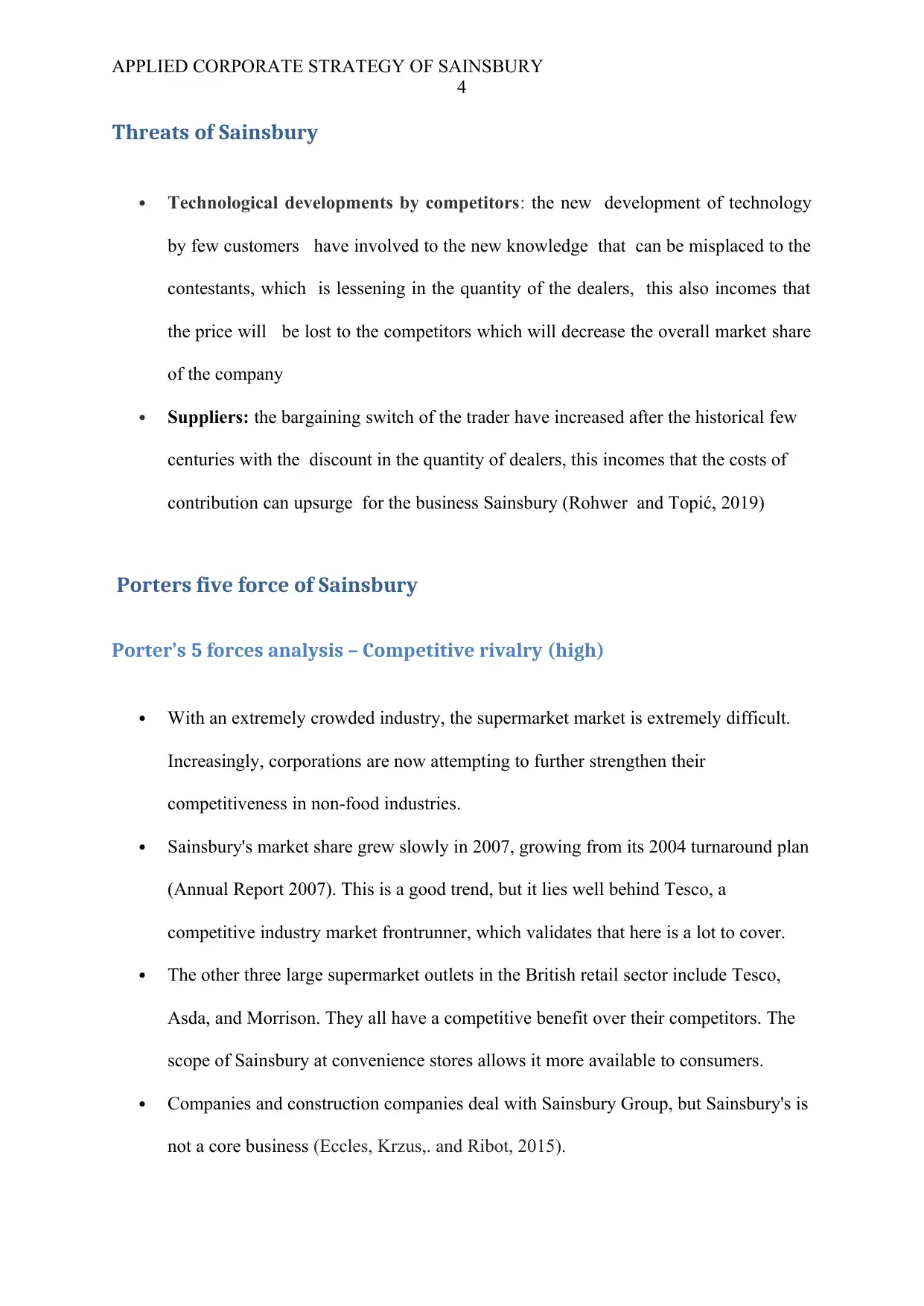
APPLIED CORPORATE STRATEGY OF SAINSBURY
4
Threats of Sainsbury
Technological developments by competitors: the new development of technology
by few customers have involved to the new knowledge that can be misplaced to the
contestants, which is lessening in the quantity of the dealers, this also incomes that
the price will be lost to the competitors which will decrease the overall market share
of the company
Suppliers: the bargaining switch of the trader have increased after the historical few
centuries with the discount in the quantity of dealers, this incomes that the costs of
contribution can upsurge for the business Sainsbury (Rohwer and Topić, 2019)
Porters five force of Sainsbury
Porter’s 5 forces analysis – Competitive rivalry (high)
With an extremely crowded industry, the supermarket market is extremely difficult.
Increasingly, corporations are now attempting to further strengthen their
competitiveness in non-food industries.
Sainsbury's market share grew slowly in 2007, growing from its 2004 turnaround plan
(Annual Report 2007). This is a good trend, but it lies well behind Tesco, a
competitive industry market frontrunner, which validates that here is a lot to cover.
The other three large supermarket outlets in the British retail sector include Tesco,
Asda, and Morrison. They all have a competitive benefit over their competitors. The
scope of Sainsbury at convenience stores allows it more available to consumers.
Companies and construction companies deal with Sainsbury Group, but Sainsbury's is
not a core business (Eccles, Krzus,. and Ribot, 2015).
4
Threats of Sainsbury
Technological developments by competitors: the new development of technology
by few customers have involved to the new knowledge that can be misplaced to the
contestants, which is lessening in the quantity of the dealers, this also incomes that
the price will be lost to the competitors which will decrease the overall market share
of the company
Suppliers: the bargaining switch of the trader have increased after the historical few
centuries with the discount in the quantity of dealers, this incomes that the costs of
contribution can upsurge for the business Sainsbury (Rohwer and Topić, 2019)
Porters five force of Sainsbury
Porter’s 5 forces analysis – Competitive rivalry (high)
With an extremely crowded industry, the supermarket market is extremely difficult.
Increasingly, corporations are now attempting to further strengthen their
competitiveness in non-food industries.
Sainsbury's market share grew slowly in 2007, growing from its 2004 turnaround plan
(Annual Report 2007). This is a good trend, but it lies well behind Tesco, a
competitive industry market frontrunner, which validates that here is a lot to cover.
The other three large supermarket outlets in the British retail sector include Tesco,
Asda, and Morrison. They all have a competitive benefit over their competitors. The
scope of Sainsbury at convenience stores allows it more available to consumers.
Companies and construction companies deal with Sainsbury Group, but Sainsbury's is
not a core business (Eccles, Krzus,. and Ribot, 2015).
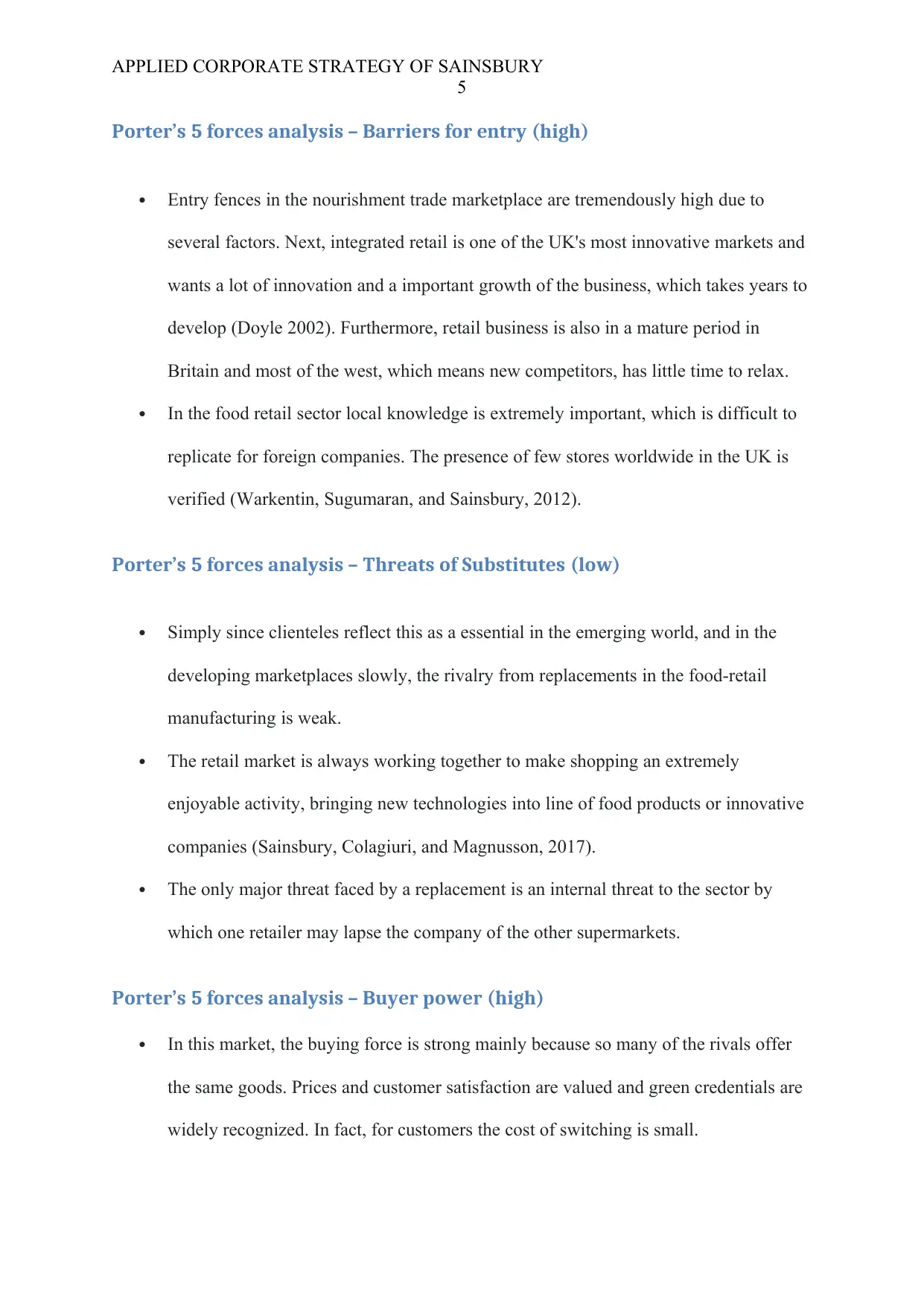
APPLIED CORPORATE STRATEGY OF SAINSBURY
5
Porter’s 5 forces analysis – Barriers for entry (high)
Entry fences in the nourishment trade marketplace are tremendously high due to
several factors. Next, integrated retail is one of the UK's most innovative markets and
wants a lot of innovation and a important growth of the business, which takes years to
develop (Doyle 2002). Furthermore, retail business is also in a mature period in
Britain and most of the west, which means new competitors, has little time to relax.
In the food retail sector local knowledge is extremely important, which is difficult to
replicate for foreign companies. The presence of few stores worldwide in the UK is
verified (Warkentin, Sugumaran, and Sainsbury, 2012).
Porter’s 5 forces analysis – Threats of Substitutes (low)
Simply since clienteles reflect this as a essential in the emerging world, and in the
developing marketplaces slowly, the rivalry from replacements in the food-retail
manufacturing is weak.
The retail market is always working together to make shopping an extremely
enjoyable activity, bringing new technologies into line of food products or innovative
companies (Sainsbury, Colagiuri, and Magnusson, 2017).
The only major threat faced by a replacement is an internal threat to the sector by
which one retailer may lapse the company of the other supermarkets.
Porter’s 5 forces analysis – Buyer power (high)
In this market, the buying force is strong mainly because so many of the rivals offer
the same goods. Prices and customer satisfaction are valued and green credentials are
widely recognized. In fact, for customers the cost of switching is small.
5
Porter’s 5 forces analysis – Barriers for entry (high)
Entry fences in the nourishment trade marketplace are tremendously high due to
several factors. Next, integrated retail is one of the UK's most innovative markets and
wants a lot of innovation and a important growth of the business, which takes years to
develop (Doyle 2002). Furthermore, retail business is also in a mature period in
Britain and most of the west, which means new competitors, has little time to relax.
In the food retail sector local knowledge is extremely important, which is difficult to
replicate for foreign companies. The presence of few stores worldwide in the UK is
verified (Warkentin, Sugumaran, and Sainsbury, 2012).
Porter’s 5 forces analysis – Threats of Substitutes (low)
Simply since clienteles reflect this as a essential in the emerging world, and in the
developing marketplaces slowly, the rivalry from replacements in the food-retail
manufacturing is weak.
The retail market is always working together to make shopping an extremely
enjoyable activity, bringing new technologies into line of food products or innovative
companies (Sainsbury, Colagiuri, and Magnusson, 2017).
The only major threat faced by a replacement is an internal threat to the sector by
which one retailer may lapse the company of the other supermarkets.
Porter’s 5 forces analysis – Buyer power (high)
In this market, the buying force is strong mainly because so many of the rivals offer
the same goods. Prices and customer satisfaction are valued and green credentials are
widely recognized. In fact, for customers the cost of switching is small.
⊘ This is a preview!⊘
Do you want full access?
Subscribe today to unlock all pages.

Trusted by 1+ million students worldwide
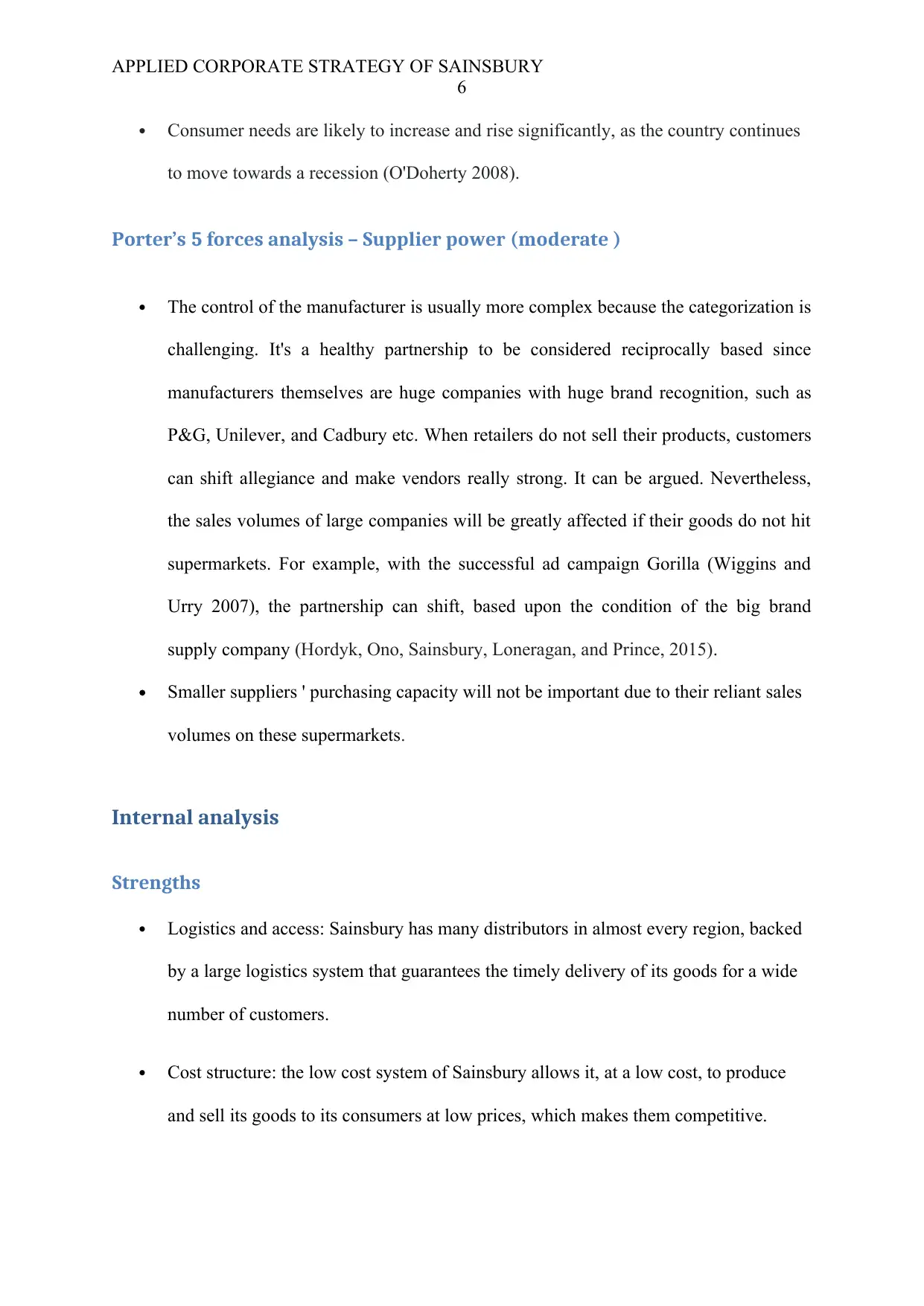
APPLIED CORPORATE STRATEGY OF SAINSBURY
6
Consumer needs are likely to increase and rise significantly, as the country continues
to move towards a recession (O'Doherty 2008).
Porter’s 5 forces analysis – Supplier power (moderate )
The control of the manufacturer is usually more complex because the categorization is
challenging. It's a healthy partnership to be considered reciprocally based since
manufacturers themselves are huge companies with huge brand recognition, such as
P&G, Unilever, and Cadbury etc. When retailers do not sell their products, customers
can shift allegiance and make vendors really strong. It can be argued. Nevertheless,
the sales volumes of large companies will be greatly affected if their goods do not hit
supermarkets. For example, with the successful ad campaign Gorilla (Wiggins and
Urry 2007), the partnership can shift, based upon the condition of the big brand
supply company (Hordyk, Ono, Sainsbury, Loneragan, and Prince, 2015).
Smaller suppliers ' purchasing capacity will not be important due to their reliant sales
volumes on these supermarkets.
Internal analysis
Strengths
Logistics and access: Sainsbury has many distributors in almost every region, backed
by a large logistics system that guarantees the timely delivery of its goods for a wide
number of customers.
Cost structure: the low cost system of Sainsbury allows it, at a low cost, to produce
and sell its goods to its consumers at low prices, which makes them competitive.
6
Consumer needs are likely to increase and rise significantly, as the country continues
to move towards a recession (O'Doherty 2008).
Porter’s 5 forces analysis – Supplier power (moderate )
The control of the manufacturer is usually more complex because the categorization is
challenging. It's a healthy partnership to be considered reciprocally based since
manufacturers themselves are huge companies with huge brand recognition, such as
P&G, Unilever, and Cadbury etc. When retailers do not sell their products, customers
can shift allegiance and make vendors really strong. It can be argued. Nevertheless,
the sales volumes of large companies will be greatly affected if their goods do not hit
supermarkets. For example, with the successful ad campaign Gorilla (Wiggins and
Urry 2007), the partnership can shift, based upon the condition of the big brand
supply company (Hordyk, Ono, Sainsbury, Loneragan, and Prince, 2015).
Smaller suppliers ' purchasing capacity will not be important due to their reliant sales
volumes on these supermarkets.
Internal analysis
Strengths
Logistics and access: Sainsbury has many distributors in almost every region, backed
by a large logistics system that guarantees the timely delivery of its goods for a wide
number of customers.
Cost structure: the low cost system of Sainsbury allows it, at a low cost, to produce
and sell its goods to its consumers at low prices, which makes them competitive.
Paraphrase This Document
Need a fresh take? Get an instant paraphrase of this document with our AI Paraphraser
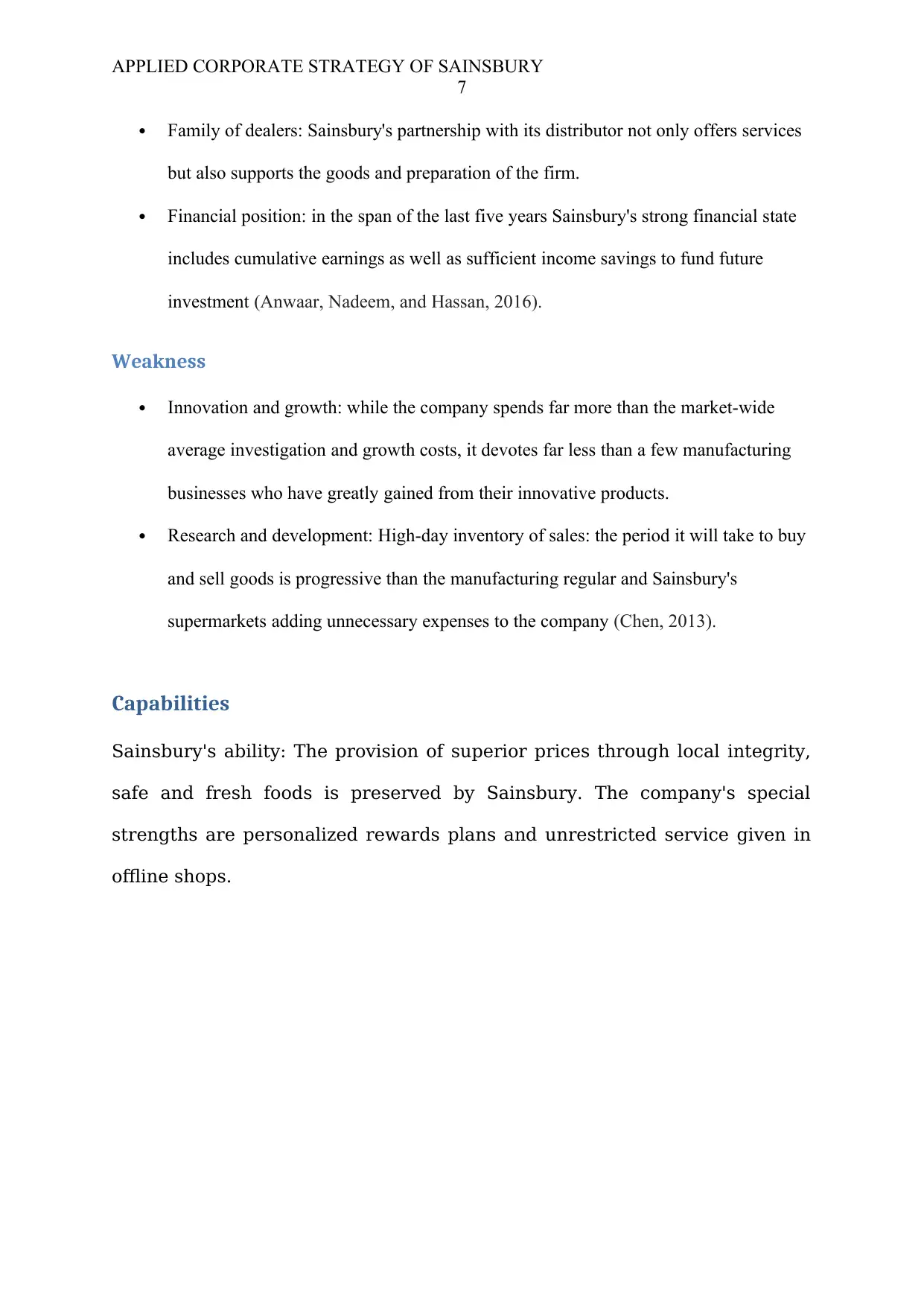
APPLIED CORPORATE STRATEGY OF SAINSBURY
7
Family of dealers: Sainsbury's partnership with its distributor not only offers services
but also supports the goods and preparation of the firm.
Financial position: in the span of the last five years Sainsbury's strong financial state
includes cumulative earnings as well as sufficient income savings to fund future
investment (Anwaar, Nadeem, and Hassan, 2016).
Weakness
Innovation and growth: while the company spends far more than the market-wide
average investigation and growth costs, it devotes far less than a few manufacturing
businesses who have greatly gained from their innovative products.
Research and development: High-day inventory of sales: the period it will take to buy
and sell goods is progressive than the manufacturing regular and Sainsbury's
supermarkets adding unnecessary expenses to the company (Chen, 2013).
Capabilities
Sainsbury's ability: The provision of superior prices through local integrity,
safe and fresh foods is preserved by Sainsbury. The company's special
strengths are personalized rewards plans and unrestricted service given in
offline shops.
7
Family of dealers: Sainsbury's partnership with its distributor not only offers services
but also supports the goods and preparation of the firm.
Financial position: in the span of the last five years Sainsbury's strong financial state
includes cumulative earnings as well as sufficient income savings to fund future
investment (Anwaar, Nadeem, and Hassan, 2016).
Weakness
Innovation and growth: while the company spends far more than the market-wide
average investigation and growth costs, it devotes far less than a few manufacturing
businesses who have greatly gained from their innovative products.
Research and development: High-day inventory of sales: the period it will take to buy
and sell goods is progressive than the manufacturing regular and Sainsbury's
supermarkets adding unnecessary expenses to the company (Chen, 2013).
Capabilities
Sainsbury's ability: The provision of superior prices through local integrity,
safe and fresh foods is preserved by Sainsbury. The company's special
strengths are personalized rewards plans and unrestricted service given in
offline shops.
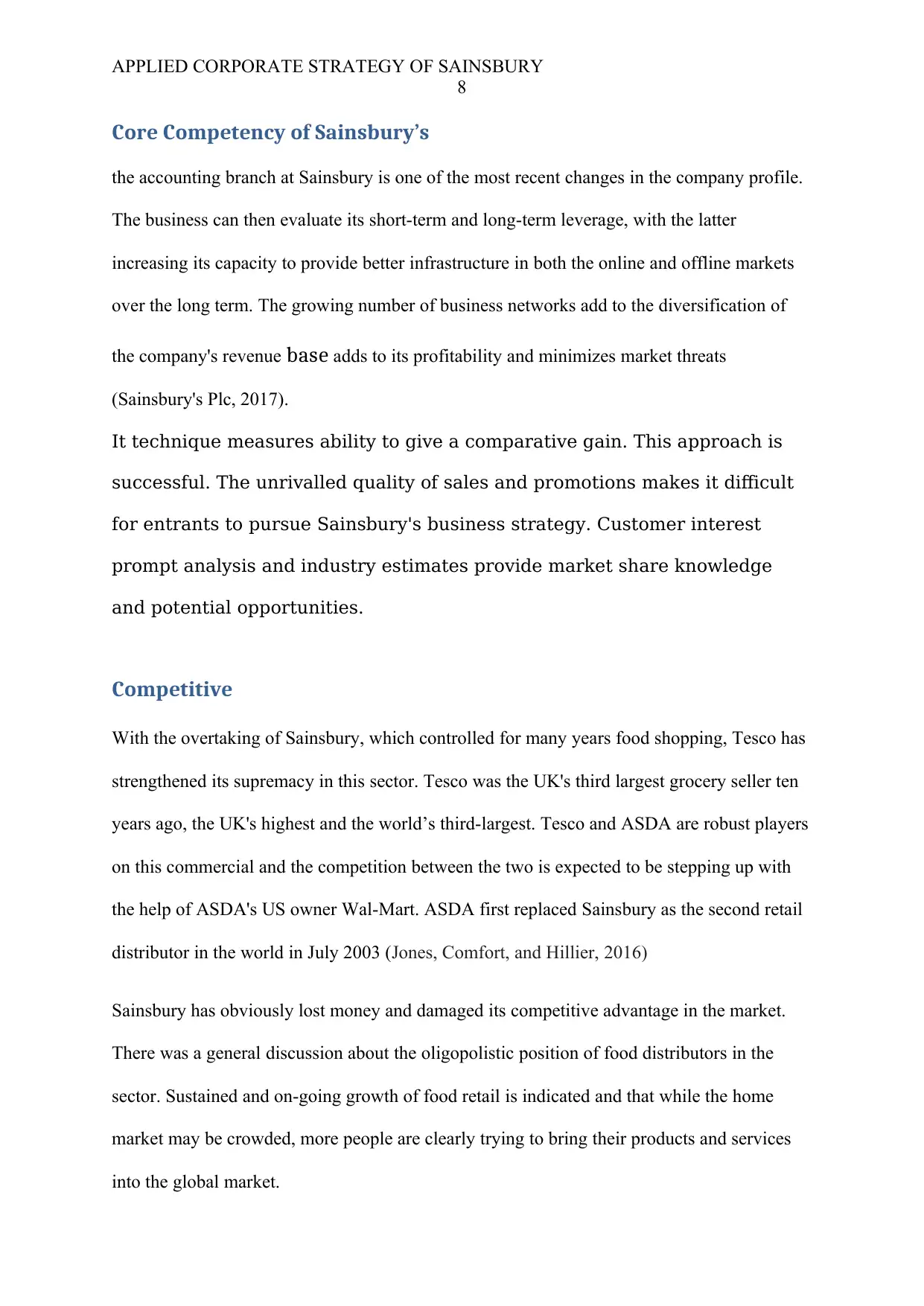
APPLIED CORPORATE STRATEGY OF SAINSBURY
8
Core Competency of Sainsbury’s
the accounting branch at Sainsbury is one of the most recent changes in the company profile.
The business can then evaluate its short-term and long-term leverage, with the latter
increasing its capacity to provide better infrastructure in both the online and offline markets
over the long term. The growing number of business networks add to the diversification of
the company's revenue base adds to its profitability and minimizes market threats
(Sainsbury's Plc, 2017).
It technique measures ability to give a comparative gain. This approach is
successful. The unrivalled quality of sales and promotions makes it difficult
for entrants to pursue Sainsbury's business strategy. Customer interest
prompt analysis and industry estimates provide market share knowledge
and potential opportunities.
Competitive
With the overtaking of Sainsbury, which controlled for many years food shopping, Tesco has
strengthened its supremacy in this sector. Tesco was the UK's third largest grocery seller ten
years ago, the UK's highest and the world’s third-largest. Tesco and ASDA are robust players
on this commercial and the competition between the two is expected to be stepping up with
the help of ASDA's US owner Wal-Mart. ASDA first replaced Sainsbury as the second retail
distributor in the world in July 2003 (Jones, Comfort, and Hillier, 2016)
Sainsbury has obviously lost money and damaged its competitive advantage in the market.
There was a general discussion about the oligopolistic position of food distributors in the
sector. Sustained and on-going growth of food retail is indicated and that while the home
market may be crowded, more people are clearly trying to bring their products and services
into the global market.
8
Core Competency of Sainsbury’s
the accounting branch at Sainsbury is one of the most recent changes in the company profile.
The business can then evaluate its short-term and long-term leverage, with the latter
increasing its capacity to provide better infrastructure in both the online and offline markets
over the long term. The growing number of business networks add to the diversification of
the company's revenue base adds to its profitability and minimizes market threats
(Sainsbury's Plc, 2017).
It technique measures ability to give a comparative gain. This approach is
successful. The unrivalled quality of sales and promotions makes it difficult
for entrants to pursue Sainsbury's business strategy. Customer interest
prompt analysis and industry estimates provide market share knowledge
and potential opportunities.
Competitive
With the overtaking of Sainsbury, which controlled for many years food shopping, Tesco has
strengthened its supremacy in this sector. Tesco was the UK's third largest grocery seller ten
years ago, the UK's highest and the world’s third-largest. Tesco and ASDA are robust players
on this commercial and the competition between the two is expected to be stepping up with
the help of ASDA's US owner Wal-Mart. ASDA first replaced Sainsbury as the second retail
distributor in the world in July 2003 (Jones, Comfort, and Hillier, 2016)
Sainsbury has obviously lost money and damaged its competitive advantage in the market.
There was a general discussion about the oligopolistic position of food distributors in the
sector. Sustained and on-going growth of food retail is indicated and that while the home
market may be crowded, more people are clearly trying to bring their products and services
into the global market.
⊘ This is a preview!⊘
Do you want full access?
Subscribe today to unlock all pages.

Trusted by 1+ million students worldwide
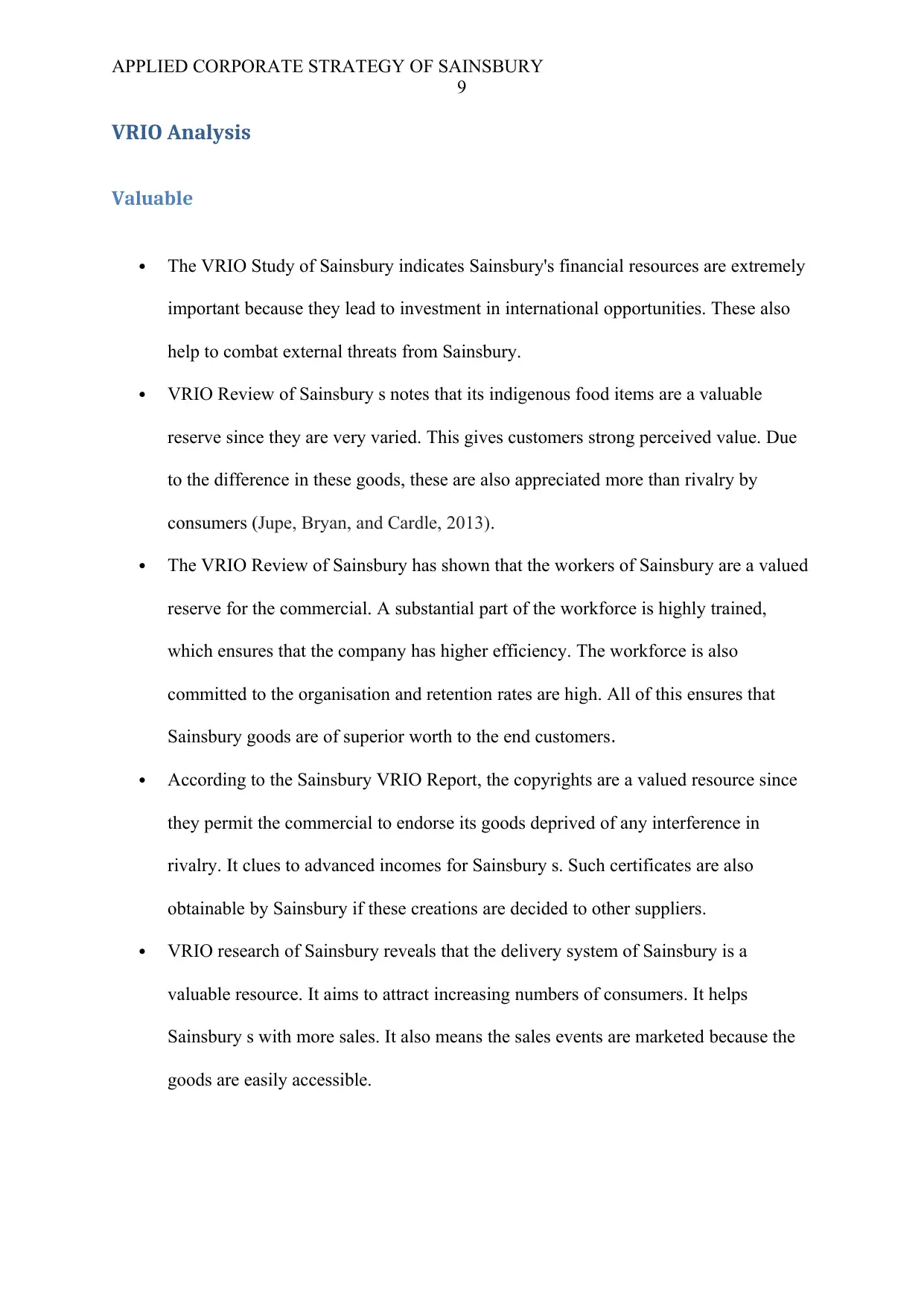
APPLIED CORPORATE STRATEGY OF SAINSBURY
9
VRIO Analysis
Valuable
The VRIO Study of Sainsbury indicates Sainsbury's financial resources are extremely
important because they lead to investment in international opportunities. These also
help to combat external threats from Sainsbury.
VRIO Review of Sainsbury s notes that its indigenous food items are a valuable
reserve since they are very varied. This gives customers strong perceived value. Due
to the difference in these goods, these are also appreciated more than rivalry by
consumers (Jupe, Bryan, and Cardle, 2013).
The VRIO Review of Sainsbury has shown that the workers of Sainsbury are a valued
reserve for the commercial. A substantial part of the workforce is highly trained,
which ensures that the company has higher efficiency. The workforce is also
committed to the organisation and retention rates are high. All of this ensures that
Sainsbury goods are of superior worth to the end customers.
According to the Sainsbury VRIO Report, the copyrights are a valued resource since
they permit the commercial to endorse its goods deprived of any interference in
rivalry. It clues to advanced incomes for Sainsbury s. Such certificates are also
obtainable by Sainsbury if these creations are decided to other suppliers.
VRIO research of Sainsbury reveals that the delivery system of Sainsbury is a
valuable resource. It aims to attract increasing numbers of consumers. It helps
Sainsbury s with more sales. It also means the sales events are marketed because the
goods are easily accessible.
9
VRIO Analysis
Valuable
The VRIO Study of Sainsbury indicates Sainsbury's financial resources are extremely
important because they lead to investment in international opportunities. These also
help to combat external threats from Sainsbury.
VRIO Review of Sainsbury s notes that its indigenous food items are a valuable
reserve since they are very varied. This gives customers strong perceived value. Due
to the difference in these goods, these are also appreciated more than rivalry by
consumers (Jupe, Bryan, and Cardle, 2013).
The VRIO Review of Sainsbury has shown that the workers of Sainsbury are a valued
reserve for the commercial. A substantial part of the workforce is highly trained,
which ensures that the company has higher efficiency. The workforce is also
committed to the organisation and retention rates are high. All of this ensures that
Sainsbury goods are of superior worth to the end customers.
According to the Sainsbury VRIO Report, the copyrights are a valued resource since
they permit the commercial to endorse its goods deprived of any interference in
rivalry. It clues to advanced incomes for Sainsbury s. Such certificates are also
obtainable by Sainsbury if these creations are decided to other suppliers.
VRIO research of Sainsbury reveals that the delivery system of Sainsbury is a
valuable resource. It aims to attract increasing numbers of consumers. It helps
Sainsbury s with more sales. It also means the sales events are marketed because the
goods are easily accessible.
Paraphrase This Document
Need a fresh take? Get an instant paraphrase of this document with our AI Paraphraser
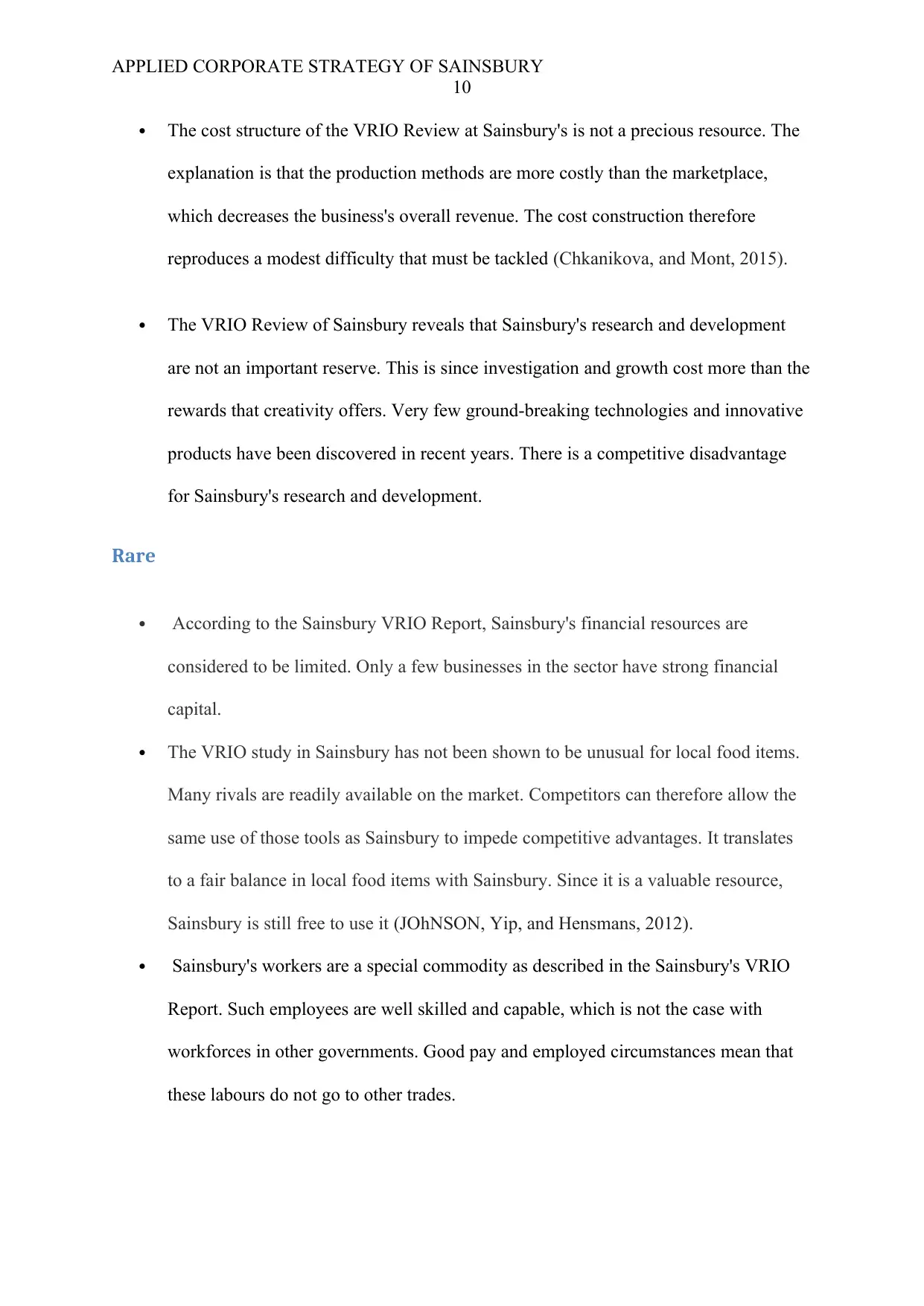
APPLIED CORPORATE STRATEGY OF SAINSBURY
10
The cost structure of the VRIO Review at Sainsbury's is not a precious resource. The
explanation is that the production methods are more costly than the marketplace,
which decreases the business's overall revenue. The cost construction therefore
reproduces a modest difficulty that must be tackled (Chkanikova, and Mont, 2015).
The VRIO Review of Sainsbury reveals that Sainsbury's research and development
are not an important reserve. This is since investigation and growth cost more than the
rewards that creativity offers. Very few ground-breaking technologies and innovative
products have been discovered in recent years. There is a competitive disadvantage
for Sainsbury's research and development.
Rare
According to the Sainsbury VRIO Report, Sainsbury's financial resources are
considered to be limited. Only a few businesses in the sector have strong financial
capital.
The VRIO study in Sainsbury has not been shown to be unusual for local food items.
Many rivals are readily available on the market. Competitors can therefore allow the
same use of those tools as Sainsbury to impede competitive advantages. It translates
to a fair balance in local food items with Sainsbury. Since it is a valuable resource,
Sainsbury is still free to use it (JOhNSON, Yip, and Hensmans, 2012).
Sainsbury's workers are a special commodity as described in the Sainsbury's VRIO
Report. Such employees are well skilled and capable, which is not the case with
workforces in other governments. Good pay and employed circumstances mean that
these labours do not go to other trades.
10
The cost structure of the VRIO Review at Sainsbury's is not a precious resource. The
explanation is that the production methods are more costly than the marketplace,
which decreases the business's overall revenue. The cost construction therefore
reproduces a modest difficulty that must be tackled (Chkanikova, and Mont, 2015).
The VRIO Review of Sainsbury reveals that Sainsbury's research and development
are not an important reserve. This is since investigation and growth cost more than the
rewards that creativity offers. Very few ground-breaking technologies and innovative
products have been discovered in recent years. There is a competitive disadvantage
for Sainsbury's research and development.
Rare
According to the Sainsbury VRIO Report, Sainsbury's financial resources are
considered to be limited. Only a few businesses in the sector have strong financial
capital.
The VRIO study in Sainsbury has not been shown to be unusual for local food items.
Many rivals are readily available on the market. Competitors can therefore allow the
same use of those tools as Sainsbury to impede competitive advantages. It translates
to a fair balance in local food items with Sainsbury. Since it is a valuable resource,
Sainsbury is still free to use it (JOhNSON, Yip, and Hensmans, 2012).
Sainsbury's workers are a special commodity as described in the Sainsbury's VRIO
Report. Such employees are well skilled and capable, which is not the case with
workforces in other governments. Good pay and employed circumstances mean that
these labours do not go to other trades.

APPLIED CORPORATE STRATEGY OF SAINSBURY
11
Sainsbury's inventions are a novelty as found by VRIO Research in Sainsbury. These
licenses are not available easily and do not belong to rivals. This allows Sainsbury to
use them deprived of the marketplace interference.
Sainsbury's distribution network is a remarkable tool defined by the Sainsbury's VRIO
Review. This is because rivals essential a lot of speculation and time to grow a better
system than Sainsbury's. Very few trades in the subdivision also own them.
Imitable
Sainsbury's monetary capitals are expensive, as labelled in the VRIO Review of
Sainsbury. Over the years, the organization has accumulated this capital by long
earnings. For a long time, new entrants and rivals would have to invest such financial
resources in equal earnings (Lu, Kamoun, and Robatzek, 2012).
It is not as costly to mimic local food items as found by the Sainsbury’s VRIO report.
These are also open to rivals if they spend significantly in research and development.
These also require no long-term knowledge of the year. Therefore, Sainsbury's local
food goods give a transient comparative gain which rivals can also obtain over time.
Sainsbury's staffs are also not difficult to emulate as shown by the VRIO review of
Sainsbury. Many businesses can also train their staff and improve their skills. They
can also attract Sainsbury workers by providing better compensation packages,
working environment, health, growth opportunities, etc. This gives Sainsbury's staff a
tool with a temporary diffident advantage. This can be achieved in the future through
rivalry.
Sainsbury's inventions are very hard to copy as the VRIO analyses of Sainsbury's
have been established. This is because a proprietary invention cannot be lawfully
11
Sainsbury's inventions are a novelty as found by VRIO Research in Sainsbury. These
licenses are not available easily and do not belong to rivals. This allows Sainsbury to
use them deprived of the marketplace interference.
Sainsbury's distribution network is a remarkable tool defined by the Sainsbury's VRIO
Review. This is because rivals essential a lot of speculation and time to grow a better
system than Sainsbury's. Very few trades in the subdivision also own them.
Imitable
Sainsbury's monetary capitals are expensive, as labelled in the VRIO Review of
Sainsbury. Over the years, the organization has accumulated this capital by long
earnings. For a long time, new entrants and rivals would have to invest such financial
resources in equal earnings (Lu, Kamoun, and Robatzek, 2012).
It is not as costly to mimic local food items as found by the Sainsbury’s VRIO report.
These are also open to rivals if they spend significantly in research and development.
These also require no long-term knowledge of the year. Therefore, Sainsbury's local
food goods give a transient comparative gain which rivals can also obtain over time.
Sainsbury's staffs are also not difficult to emulate as shown by the VRIO review of
Sainsbury. Many businesses can also train their staff and improve their skills. They
can also attract Sainsbury workers by providing better compensation packages,
working environment, health, growth opportunities, etc. This gives Sainsbury's staff a
tool with a temporary diffident advantage. This can be achieved in the future through
rivalry.
Sainsbury's inventions are very hard to copy as the VRIO analyses of Sainsbury's
have been established. This is because a proprietary invention cannot be lawfully
⊘ This is a preview!⊘
Do you want full access?
Subscribe today to unlock all pages.

Trusted by 1+ million students worldwide
1 out of 18
Related Documents
Your All-in-One AI-Powered Toolkit for Academic Success.
+13062052269
info@desklib.com
Available 24*7 on WhatsApp / Email
![[object Object]](/_next/static/media/star-bottom.7253800d.svg)
Unlock your academic potential
Copyright © 2020–2025 A2Z Services. All Rights Reserved. Developed and managed by ZUCOL.




